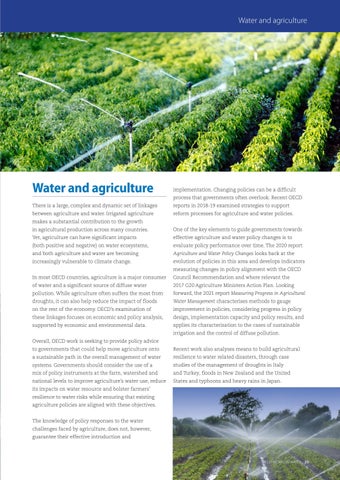Water and agriculture
Water and agriculture
implementation. Changing policies can be a difficult
There is a large, complex and dynamic set of linkages
reports in 2018-19 examined strategies to support
between agriculture and water. Irrigated agriculture
reform processes for agriculture and water policies.
process that governments often overlook. Recent OECD
makes a substantial contribution to the growth in agricultural production across many countries.
One of the key elements to guide governments towards
Yet, agriculture can have significant impacts
effective agriculture and water policy changes is to
(both positive and negative) on water ecosystems,
evaluate policy performance over time. The 2020 report
and both agriculture and water are becoming
Agriculture and Water Policy Changes looks back at the
increasingly vulnerable to climate change.
evolution of policies in this area and develops indicators measuring changes in policy alignment with the OECD
In most OECD countries, agriculture is a major consumer
Council Recommendation and where relevant the
of water and a significant source of diffuse water
2017 G20 Agriculture Ministers Action Plan. Looking
pollution. While agriculture often suffers the most from
forward, the 2021 report Measuring Progress in Agricultural
droughts, it can also help reduce the impact of floods
Water Management characterises methods to gauge
on the rest of the economy. OECD’s examination of
improvement in policies, considering progress in policy
these linkages focuses on economic and policy analysis,
design, implementation capacity and policy results, and
supported by economic and environmental data.
applies its characterisation to the cases of sustainable irrigation and the control of diffuse pollution.
Overall, OECD work is seeking to provide policy advice to governments that could help move agriculture onto
Recent work also analyses means to build agricultural
a sustainable path in the overall management of water
resilience to water related disasters, through case
systems. Governments should consider the use of a
studies of the management of droughts in Italy
mix of policy instruments at the farm, watershed and
and Turkey, floods in New Zealand and the United
national levels to improve agriculture’s water use, reduce
States and typhoons and heavy rains in Japan.
its impacts on water resource and bolster farmers’ resilience to water risks while ensuring that existing agriculture policies are aligned with these objectives. The knowledge of policy responses to the water challenges faced by agriculture, does not, however, guarantee their effective introduction and
OECD WORK ON WATER 23











